Database Normalization
Normalization is critical to most database designs. This article/tutorial will explain what database normalization is, why you need it and how to normalize a data model. We will use a simple example (made with data modeling tool DeZign for Databases) to explain the normalization rules.
What is Database Normalization
Database normalization is a technique of organizing the data in the database. Normalization is a formal approach that applies a set of rules to associate attributes with entities. Normalization is used when designing a database.
Database normalization is mainly used to:
- Eliminate reduntant data.
- Ensure data is logically stored (results in a more flexible data model).
Normalization of a data model consists of several steps. These steps are called normalization rules. Each rule is referred to as a normal form (1NF, 2NF, 3NF). The first three forms are the most important ones. There are more than 3 normal forms but those forms are rarely used and can be ignored without resulting in a non flexible data model. Each normal form constrains the data more than the previous normal form. This means that you must first achieve the first normal form (1NF) in order to be able to achieve the second normal form (2NF). You must achieve the second normal form before you can achieve the third normal form (3NF).
0NF: Not Normalized
The data in the table below is not normalized because it contains repeating attributes (contact1, contact2,...).

Not normalized customer data.
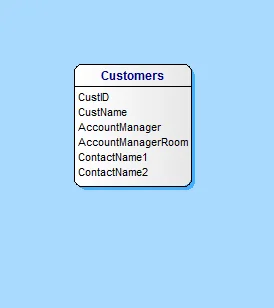
Not normalized (0NF) table/entity in a data model.
1NF: No Repeating Groups
In the first normal form, an entity contains no repeating groups and all attributes must have a unique name.
Entities may only consist of two dimensions. A Customer has multiple Contacts (contact1, contact2,...). This is why we must create a new entity for the contacts. A data model containing attributes with names like contact1, contact2 etc, is a bad database design. Repeating attributes make your data less flexible and make it difficult to search for data.
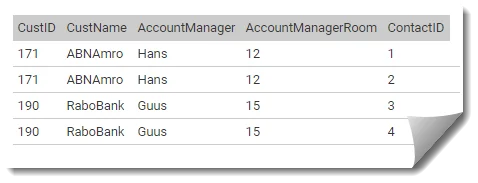
Customers.
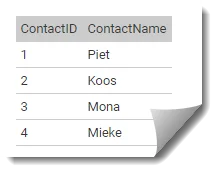
Contacts.
2NF: Eliminate Redundant Data
An entity is in the second normal form if it has achieved the first normal form and if all of its attributes depend on the complete (primary) key. An entity with a primary key consisting of only one attribute is in the second normal form (2NF).
In our example, the key is CustID + ContactID. If we remove the ContactID attribute we ensure that all attributes in the Customer entity depend on the new primary key CustID. We create a new entity CustomerContact for the relationship between Customer and Contact.

Customers.
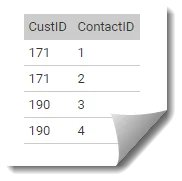
CustomerContacts.
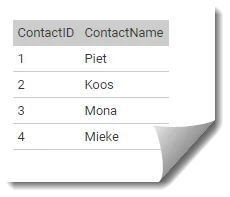
Contacts.
3NF: Eliminate Transitive Dependency
An entity is in the third normal form (3NF) if it is in the second normal form and all of its attributes are not transitively dependent on the complete primary key. Transitive dependency exists when a non-prime attribute depends on other non-prime attributes rather than depending upon the prime attributes or primary key. In other words: The third normal form means that no attribute within an entity is dependent on an non-prime attribute that, in turn, depends on the primary key.
In our example, attribute AccountManagerRoom is transitive dependent on attribute AccountManager. A new entity AccountManager must be created so that we can remove attribute AccountManagerRoom from the Customer entity. The Customer entity is now in the third normal form (3NF).
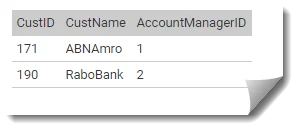
Customers.
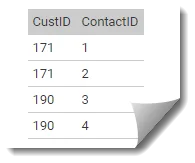
CustomerContacts.
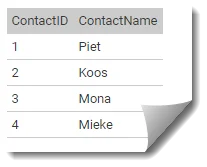
Contacts.

AccountManagers.
Data Model After Normalization
This is the data model after database normalization (3NF):
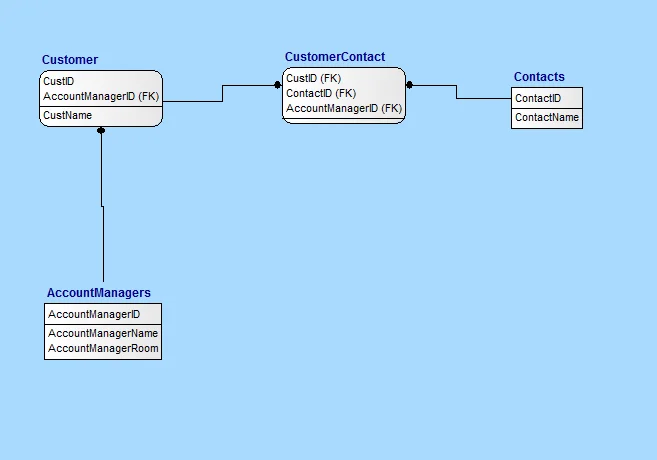
Data model after database normalization.
